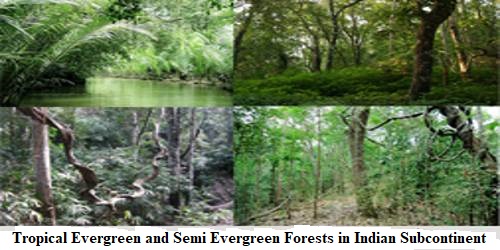Tropical Evergreen and Semi Evergreen Forests in Indian Subcontinent
The tropical evergreen forests usually occur in areas receiving more than 200 cm of rainfall and having a temperature of 15 to 30 degrees Celsius. They occupy about seven percent of the earth’s land surface and harbors more than half of the world’s plants and animals. Semi-Evergreen Forests indicate a forest that consists of a mixture of deciduous and evergreen woody plants in the tropics and semi-tropics. It differs in its use from a mixed forest, a term usually applied to woods that contain both conifers and broad-leaved trees.
These forests are found in the western slope of the Western Ghats, hills of the northeastern region and the Andaman and Nicobar Islands. They are found in warm and humid areas with an annual precipitation of over 200 cm and mean annual temperature above 22°C. Tropical evergreen forests are well stratified, with layers closer to the ground and are covered with shrubs and creepers, with short structured trees followed by a tall variety of trees. In these forests, trees reach great heights up to 60 m or above. There is no definite time for trees to shed their leaves, flowering, and fruition. As such these forests appear green all the year round. Species found in these forests include rosewood, mahogony, aini, ebony, etc.

The semi-evergreen forests are found in the less rainy parts of these regions. Such forests have a mixture of evergreen and moist deciduous trees. The under growing climbers provide an evergreen character to these forests. Main species are white cedar, hollock, and kail.
The British were aware of the economic value of the forests in India; hence, large-scale exploitation of these forests was started. The structure of forests was also changed. The oak forests in Garhwal and Kumaon were replaced by pine (chins) which was needed to lay railway lines. Forests were also cleared for introducing plantations of tea, rubber, and coffee. The British also used timber for construction activities as it acts as an insulator of heat. The protection use of forests was, thus, replaced by commercial use.














